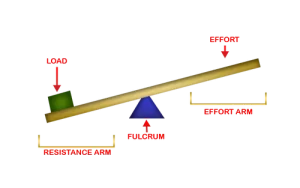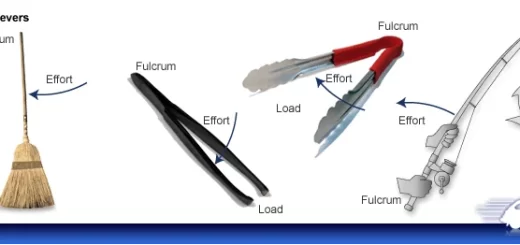Structure and the importance of the levers
The levers are the most common simple machines that help man to perform heavy tasks easily. They were first described in 260 B.C, The liver is affected by an effort force and a resistance force, and it is a rigid bar (straight or curved) that rotates around a fixed point called the fulcrum.
Structure of the lever
The liver consists of:
-
A resistance force is a force that results from the weight of the body that we want to move.
-
An effort force is a force that is exerted by a person to equilibrate the resistance.
-
The fulcrum is a fixed point, where the bar rotates around.
Examples of levers
Stapler, Manual broom, Crowbar, Seesaw, Scissors, Bottle opener, Nutcracker, Ice or Sweet Holder and Wheelbarrow.
Importance of levers
-
The levers increase the force because they save the exerted effort by using the small force to make a great effort as moving a heavy load.
Examples: crowbar, bottle (soda water) opener, Nutcracker & wheelbarrow.
-
They increase the distance, where some levers allow the exerting force for a small distance to move an object for a longer distance.
Examples: The manual broom, If your hand moves a small distance at the upper part of the manual broom, the lower part will move a longer distance.
- They avoid dangers as they are used to pick up hot, cold and poisonous materials. Examples: Ice holder and coal holder (coal tongs).
-
They increase the speed of the objects that we affect.
Examples: Hockey bat.
-
They move the force from one place to another.
Examples: The force of your hand on the manual broom moves from one place to another to collect the garbage without bending.
-
They have accuracy in performance as they are used to pick up a tiny object.
Example: Tweezers.
Examples of first, second, and third class levers
Levers are classified into three types based on the arrangement of the fulcrum (pivot), effort (force applied), and load (resistance):
1. First-Class Lever (Fulcrum in the Middle)
- Structure: Effort — Fulcrum — Load.
- The fulcrum is in the center, with effort applied on one side and the load on the other.
- Examples: Crowbar, Scissors, Pliers, Balance scale, and Seesaw.
2. Second-Class Lever (Load in the Middle)
- Structure: Effort — Load — Fulcrum.
- Example: Wheelbarrow.
- The wheel (fulcrum) is at one end, the load is in the middle, and effort is applied at the handles.
- Other Examples: Bottle opener, Nutcracker, and Door (hinge as fulcrum, effort applied at handle).
3. Third-Class Lever (Effort in the Middle)
- Structure: Fulcrum — Effort — Load
- Example: Tweezers.
- The fulcrum is at one end, the effort is applied in the middle, and the load is at the opposite end.
- Other Examples: Fishing rod, Broom, and Human arm (lifting a weight using biceps).
Each type of lever is used in different applications to maximize efficiency depending on the task.
You can follow Science Online on Youtube from this link: Science online


